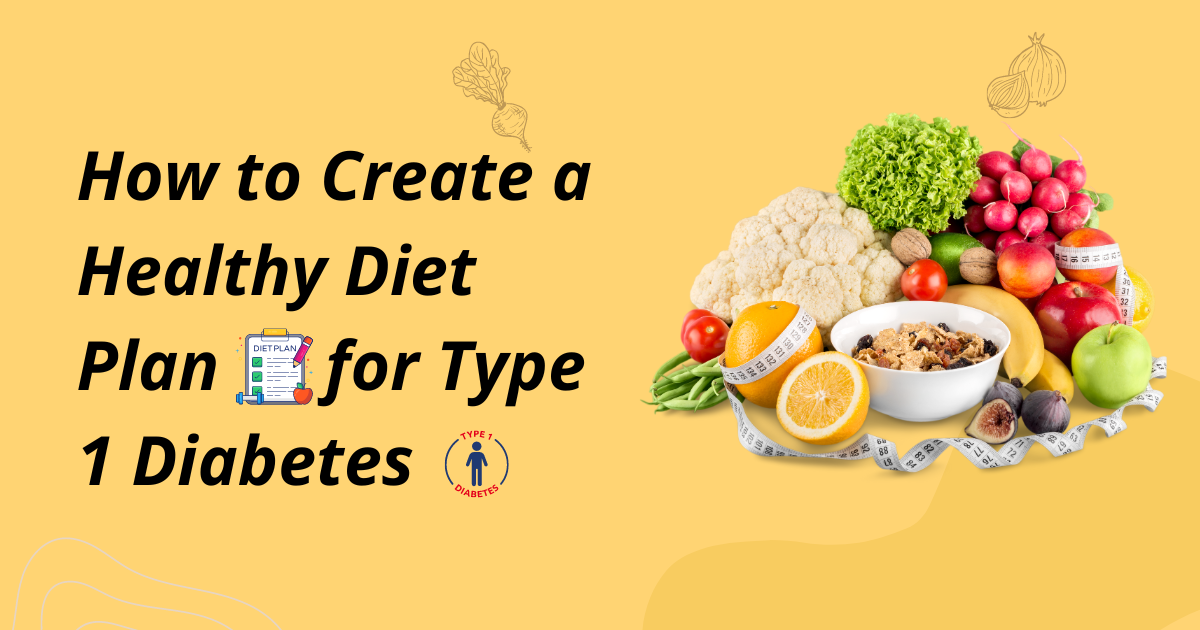Introduction:
Creating a balanced diet plan for type 1 diabetes is essential for managing blood sugar levels and ensuring overall health. Unlike type 2 diabetes, type 1 diabetes requires careful planning and monitoring to maintain stable glucose levels. The key difference is the lack of sufficient Insulin in Type I vs Insulin resistance in Type 2 diabetes mellitus. Developing a healthy diet plan for Type I diabetes patients involves a close relationship between patients and dieticians. There should be a balance between taste and variety also, as it is a lifelong commitment to adhere to a strict diet.
Understanding the Type 1 Diabetes Diet
A well-structured type 1 diabetes diet is crucial in managing blood sugar levels. This diet should include a balanced intake of carbohydrates, proteins, and fats, carefully monitoring portion sizes and meal timing.
Importance of Macronutrients:
- Carbohydrates: Carbs have the most significant impact on blood sugar levels. It’s vital to count carbs accurately and balance them with your insulin doses. Integrating low-GI foods into your type 1 diabetes meal plan can help keep blood sugar levels stable. A higher carbohydrate load, especially from processed carbohydrates, will require higher doses of insulin. High levels of insulin lead to fat storage, obesity, fatty liver, and other complications. Over time, this can cause insulin resistance, leading to even higher doses of insulin. High insulin levels in the body are linked to many harmful effects on organs. Therefore, focusing on low-GI and low glycemic load carbohydrates is key to long-term health in managing diabetes.
- Proteins: Proteins are essential for muscle repair and growth and have a minimal effect on blood sugar. Including high plant protein sources, such as legumes and nuts, can be beneficial for those looking to manage their diabetes through a balanced diet.
- Fats: Healthy fats support heart health. Focus on unsaturated fats particularly fates with Omega 3 from sources like Fish, Nuts and seeds ( flax seeds, walnuts and Soybean oil and other oils like Avocado and Olive oils. Avocado and Olive oils do not have substantial amounts of Omega 3! But they are very good for health.
Timing Your Meals:
- Eating at regular intervals helps in maintaining stable blood sugar levels. Consistent meal timing is a key part of an effective type 1 diabetes meal plan.
- Include healthy snacks between meals directed by dieticians
Managing Blood Sugar with the Right Foods
Carb Counting and Insulin Management:
- Understanding how different foods affect your blood sugar is critical. Carb counting is a fundamental aspect of any diet plan for type 1 diabetes. Use apps or carb-counting guides to accurately track your intake.
The Role of Glycemic Index (GI):
- Opt for low-GI foods, as they cause slower rises in blood sugar levels. Examples include most fruits, legumes, and whole grains.
- Avoid high-GI foods like white bread and sugary cereals, which can cause significant blood sugar spikes.
Foods to Avoid with Type 1 Diabetes
Certain foods can drastically affect blood sugar levels and should be limited or avoided in a type 1 diabetes diet.
Sugary Foods:
- Avoid foods high in added sugars like sodas, candies, and desserts. These can cause rapid spikes in blood sugar and contribute to insulin resistance.
Refined Carbohydrates:
- Foods like white bread, white rice, and pasta are high in refined carbs, which can quickly elevate blood sugar levels.
Trans Fats:
- Found in fried foods and commercially baked goods, trans fats increase the risk of heart disease and should be avoided in a type 1 diabetic diet food list.
Post prandial blood sugar spike has been implicated as the most important factor in the log term morbidity of diabetics. Both the initial spike and delayed plateau of the blood sugar post meal are equally important. High glycemic index and load foods have been shown to have a very high spike and plateau . Low Glycemic index foods are the key as we donot want to substitute fats for Carbohydrates also ( keto diets). Also an interesting concept is emerging where post prandial exercise: immediately after a meal is proving to have a wonderful on post prandial blood sugar Spike and Plateau. Simple walking for even 1o minutes has shown to have a very good effect in controlling blood sugar levels.
Conclusion
Creating a healthy diet plan for type 1 diabetes is all about balance and careful monitoring of simple carbohydrates. Consumption of complex carbohydrates will be the key to health. . By focusing on nutrient-rich foods, controlling portion sizes, and avoiding items that can spike your blood sugar, you can effectively manage your diabetes and maintain a healthy lifestyle.
Disclaimer:
Please consult your dietitian or doctor before making any changes to your diet to ensure it meets your specific health needs.


